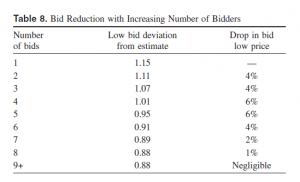Reduced Competition Increases Costs
One fundamental economic principle is rarely wrong: Reduced competition increases costs.
It is a fairly intuitive premise. Unfortunately, some government officials (often controlled by special interests) fail to grasp this basic economic concept. They often unwittingly—or even worse, knowingly—implement policies that unfairly cater to special interests or address both legitimate and erroneous public policy concerns at the expense of competition.
Research
A November 2005 study published in the Journal of Construction Engineering and Management by Cornell Professor Paul G. Carr quantified how more competition and bidders for construction contracts benefits taxpayers and project owners.
The study, Investigation of Bid Price Competition Measured through Prebid Project Estimates, Actual Bid Prices, and Number of Bidders, found “reducing the number of bidders will result in increased project bid prices.”
Carr’s research found “a statistically significant relationship between the number of bidders on a project and the low bid received, relative to the project budget” and a “negative correlation indicating the higher the number of bidders participating, the lower the bid price.”
Carr’s research expands on this finding in an effort to measure how much a restriction of bidder participation negatively impacts project costs:
“It is fine to establish that there is a correlation, but the real question is one of impact. The question then becomes, what is the relationship of bidding activity and the prediction of the impact of the projects’ cost. …In other words, if there were one less bidder, the predicted impact on the project’s budget would be of interest.”
Table 8 from the Carr study measures the relationship between the number of bidders and bid prices: 
In the real world, these findings mean an owner of a taxpayer-funded project, such as a school board or a county seeking to build a school or a government office building, would experience a considerable reduction in bid costs if it received seven bidders. As a result of this robust competition, bid prices would be reduced by 27 percent compared to if the owner only received one bid.
The public entity building the taxpayer-funded project can expect to receive bid prices close to the original estimate if there are four to five bidders. However, the owner is leaving 11 percent in bid cost savings on the table if it does not receive a total of seven bids.
On taxpayer-funded construction projects, government officials should be doing all they can to find savings and increase competition.
Competition works. It is in the public interest, as there is no credible evidence to suggest that less competition results in lower prices or better quality, especially when contractors are already held to rigorous laws, regulations, market forces and prequalification standards in public contracting.
Competition and Government-Mandated PLAs
During the contentious debate concerning the use of government-mandated projects labor agreements (PLAs), pro-PLA officials often ignore the economic principle that reduced competition increases costs. Arguments asserting a reduced pool of qualified bidders will have no impact on the cost of taxpayer-funded construction projects are misguided.
Within the context of the PLA debate, evidence suggests that PLAs reduce competition. For example, two recent polls of ABC member general contractors and subcontractors found approximately 98 percent of respondents would be less likely to bid on a public construction project that requires a firm to sign a government-mandated PLA.
Anecdotal evidence suggests that reduced competition coupled with the implementation of costly pro-union terms contained in typical PLAs (such as language related to forced contributions to troubled union pension plans and following inefficient union work rules), results in increased costs.
For example, an entire chapter from Maury Baskin’s Government-Mandated Project Labor Agreements: The Public Record of Poor Performance (2011 Edition) documents anecdotes of reduced competition on government-mandated PLA projects such as the Ohio State School for the Blind and the Ohio School for the Deaf, which TheTruthAboutPLAs.com wrote about extensively here and here in 2010.
Quantitative data also supports the premise that government-mandated PLAs increase costs. A number of studies found that prevailing wage construction projects subject to government-mandated PLAs face increased costs between 12 percent and 18 percent when compared to similar prevailing wage construction projects not subject to government-mandated PLAs. (See recent research from the National University System Institute for Policy Research in California and the Beacon Hill Institute in Massachusetts).
Because of compelling evidence indicating government-mandated PLAs reduce competition and increase costs, government-mandated PLA supporters have recently advanced a series of weak arguments—unsupported by research or reliable data—promoting their anti-competitive and costly agenda.
Here are some common arguments:
- PLAs encourage competition from union contractors that will not bid on non-PLA projects.
- PLAs reduce costs.
- Union workers are more productive than nonunion workers, so that translates into greater labor productivity on PLA projects.
TheTruthAboutPLAs.com has addressed these flimsy arguments in previous posts. More posts directly highlighting the specific flaws of each argument, and other pro-PLA arguments, will be added soon.
In the interim, remember that taxpayers are best served by free and open competition without government-mandated PLAs.
If a bidder wants to voluntarily enter into a PLA, it will do so once it has accurately determined how a PLA will deliver to taxpayers the best project at the best price. The government should not impose PLAs on contractors because of political expediency and the influence of special interests.













2 Responses to Reduced Competition Increases Costs
[…] TheTruthAboutPLAs.com explained how government-mandated project labor agreements (PLAs)reduce competition and increase costs. […]
[…] study published in the Journal of Construction Engineering and Management by Cornell professor Paul G. […]